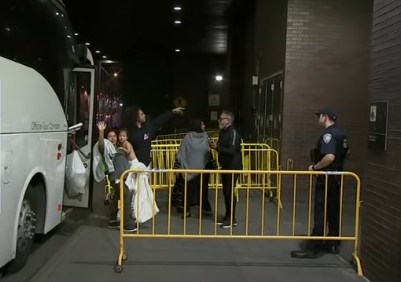The migrant crisis in New York City is seeing a significant shift as the influx of new arrivals slows down. After facing a peak of approximately 4,000 migrants entering the city each week, current numbers have dropped to about 600 migrants arriving weekly. This downturn offers some relief to the city’s overwhelmed shelter system, but experts and officials caution that it could take up to two years to achieve stability in housing and resources for migrants in the city.

Declining Shelter Needs and Shelter Site Closures
Mayor Eric Adams recently highlighted the decreasing demand on the city’s shelter system. As the number of migrants arriving in the city declines, the number of operational shelters has also decreased. At the height of the crisis, New York City was opening multiple new shelter sites to accommodate the influx of individuals and families in need of temporary housing. Now, with the slowdown, the city is beginning to close some of those shelters, bringing the number of migrant shelters down to ten.
One example of the changing shelter situation is the closure of the Hotel Merritt on West 46th Street, which previously housed dozens of migrant families. With no new families arriving to fill these spaces, the hotel is now empty, and the migrants who once stayed there have moved on. Some have been able to find more permanent housing, while others have relocated to other parts of the city or neighboring areas.
According to officials, around 58,000 migrants are still under the care of New York City, which includes those housed in various temporary facilities throughout the city and surrounding areas. The decline in new arrivals has provided a brief opportunity to manage resources more efficiently, but the city’s Deputy Mayor, Anne Williams-Isom, points out that there is still a long road ahead.
Transition and Integration: Migrants Moving into the Community
While the influx of migrants is slowing, many individuals and families who arrive in the city have been actively working to integrate and find their own housing. Murad Wilder, a representative from the New York Immigration Coalition, shared that many migrants are achieving a degree of independence within just 30 to 45 days of their arrival. During this time, they are often able to secure work, earn enough to cover basic expenses, and rent a room or apartment. This quick transition to self-sufficiency has been a crucial factor in easing the strain on the city’s shelters.
One of the former residents of the Merritt shelter, Eduardo Quinonez Araojo, who fled Venezuela, has since been able to secure a work permit and now lives with his family in Brooklyn. Eduardo shared that, in his home country, he once owned a business, and although he hopes to return one day if conditions improve, he is currently working as a delivery driver in New York City to support his family. Stories like Eduardo’s are common among the city’s migrant population, where the hope of a better life drives people to quickly integrate into the community.
Challenges Ahead as NYC Migrant Shelter System Seeks Stability
Despite the recent decrease in migrant arrivals, stabilizing the shelter system is still expected to take time. City officials estimate that it may take up to two years before the system is fully stabilized and able to meet ongoing demands without the constant pressure for expansion. The gradual decline in new arrivals has allowed the city to shift its focus from emergency shelter expansion to potentially more sustainable solutions, such as facilitating access to affordable housing options and employment opportunities.
However, questions remain about the future of the migrant community in New York City, particularly as federal and state policies on immigration and border control continue to evolve. With the possibility of Donald Trump taking office in January, some residents and migrants are unsure about what this could mean for immigration policy and enforcement. The city’s current approach emphasizes humane support for migrants, but any change in federal immigration laws could impact how New York City handles future arrivals.
Community Perspectives on Migrant Presence in NYC
Amid the political and logistical challenges, there is also a strong community response to the migrant situation in New York City. Many residents support the city’s efforts to assist migrant families and welcome them into the community. Local residents like Brant Gilot, who lives near the Merritt Hotel, expressed his support for the migrants, describing them as “hardworking people” who are simply seeking a better life. Gilot’s perspective is one shared by many in New York City who believe the city has a responsibility to help those in need.
This sentiment has contributed to a complex but largely supportive environment where New Yorkers try to balance compassion with the practical realities of limited resources. As the crisis evolves, advocates for migrant rights continue to work alongside local and city officials to ensure that the needs of both migrants and long-time residents are met.
Future Prospects: A Path Toward Stability
While New York City’s migrant crisis appears to be easing, officials warn that the situation is far from resolved. The city’s focus is shifting from an immediate response to long-term stability. Deputy Mayor Anne Williams-Isom voiced a cautious optimism, stating that while the crisis is not over, the city’s ability to start closing shelters rather than opening new ones is a positive sign. This shift reflects a hope that New York City can continue to support incoming migrants effectively while also managing the needs of its existing population.
The future of the migrant community in New York City may hinge on broader changes in immigration policy, economic conditions, and support from other levels of government. For now, the city’s efforts are focused on transitioning migrants into stable housing and employment as quickly as possible. If these efforts are successful, New York City could eventually reach a point where its shelter system is sustainable and less dependent on emergency measures, creating a more balanced approach to addressing the ongoing migrant crisis.

















